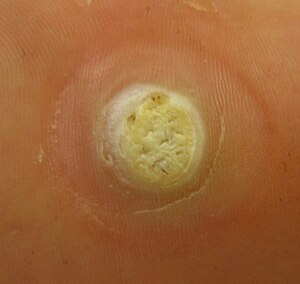Verruca
| Plantar wart | |
|---|---|
| Synonyms | verruca, myrmecia, verruca plantaris |
 |
|
| Large plantar wart | |
| Classification and external resources | |
| Specialty | Dermatology |
| ICD-10 | B07 |
| ICD-9-CM | 078.12 |
A plantar wart is a wart occurring on the sole or toes of the foot. They are caused by the human papillomavirus (HPV). HPV infections in other locations are not plantar warts.
Plantar warts are usually self-limiting, but treatment is generally recommended to lessen symptoms (which may include pain), decrease duration, and reduce transmission. Infection occurs in an estimated 7–10% of the US population, and genetics plays an important role in determining susceptibility.
Plantar warts are benign epithelial tumors generally caused by infection by human papilloma virus types 1, 2, 4, 60, or 63, but have also been caused by types 57, 65, 66, and 156. These types are classified as clinical (visible symptoms). The virus attacks compromised skin through direct contact, entering through possibly tiny cuts and abrasions in the stratum corneum (outermost layer of skin). After infection, warts may not become visible for several weeks or months. Because of pressure on the sole of the foot or finger, the wart is pushed inward and a layer of hard skin may form over the wart. A plantar wart can be painful if left untreated.
Warts may spread through autoinoculation, by infecting nearby skin or by infected walking surfaces. They may fuse or develop into clusters called mosaic warts.
A plantar wart. Striae (fingerprints) go around the lesion.
Mosaic warts cluster
Young plantar warts
A plantar wart is a small lesion that appears on the surface of the skin and typically resembles a cauliflower, with tiny black petechiae (tiny hemorrhages under the skin) in the center. Pinpoint bleeding may occur when these are scratched. Plantar warts occur on the soles of feet and toes. They may be painful when standing or walking.
Plantar warts are often similar to calluses or corns, but can be differentiated by close observation of skin striations. Feet are covered in skin striae, which are akin to fingerprints on the feet. Skin striae go around plantar warts; if the lesion is not a plantar wart, the striations continue across the top layer of the skin. Plantar warts tend to be painful on application of pressure from either side of the lesion rather than direct pressure, unlike calluses (which tend to be painful on direct pressure instead).
...
Wikipedia
